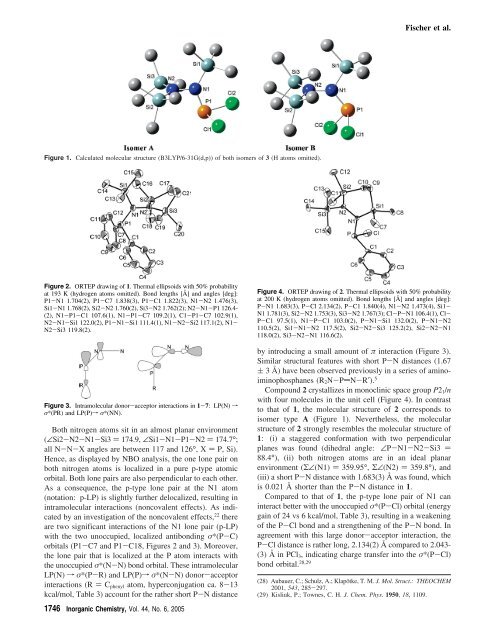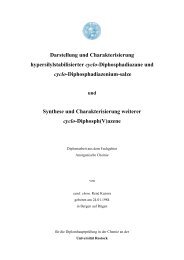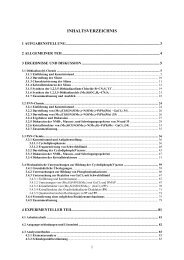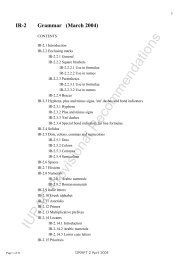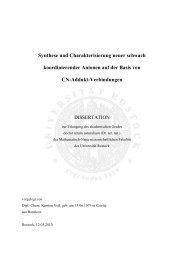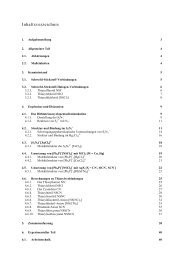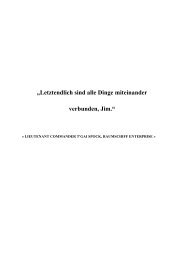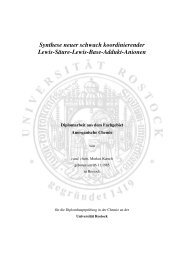Darstellung und Charakterisierung neuer niedrigkoordinierter ...
Darstellung und Charakterisierung neuer niedrigkoordinierter ...
Darstellung und Charakterisierung neuer niedrigkoordinierter ...
You also want an ePaper? Increase the reach of your titles
YUMPU automatically turns print PDFs into web optimized ePapers that Google loves.
Figure 1. Calculated molecular structure (B3LYP/6-31G(d,p)) of both isomers of 3 (H atoms omitted).<br />
Figure 2. ORTEP drawing of 1. Thermal ellipsoids with 50% probability<br />
at 193 K (hydrogen atoms omitted). Bond lengths [Å] and angles [deg]:<br />
P1-N1 1.704(2), P1-C7 1.838(3), P1-C1 1.822(3), N1-N2 1.476(3),<br />
Si1-N1 1.768(2), Si2-N2 1.760(2), Si3-N2 1.762(2); N2-N1-P1 126.4-<br />
(2), N1-P1-C1 107.6(1), N1-P1-C7 109.2(1), C1-P1-C7 102.9(1),<br />
N2-N1-Si1 122.0(2), P1-N1-Si1 111.4(1), N1-N2-Si2 117.1(2), N1-<br />
N2-Si3 119.8(2).<br />
Figure 3. Intramolecular donor-acceptor interactions in 1-7: LP(N)f<br />
σ*(PR) and LP(P)f σ*(NN).<br />
Both nitrogen atoms sit in an almost planar environment<br />
(∠Si2-N2-N1-Si3 ) 174.9, ∠Si1-N1-P1-N2 ) 174.7°;<br />
all N-N-X angles are between 117 and 126°, X) P, Si).<br />
Hence, as displayed by NBO analysis, the one lone pair on<br />
both nitrogen atoms is localized in a pure p-type atomic<br />
orbital. Both lone pairs are also perpendicular to each other.<br />
As a consequence, the p-type lone pair at the N1 atom<br />
(notation: p-LP) is slightly further delocalized, resulting in<br />
intramolecular interactions (noncovalent effects). As indicated<br />
by an investigation of the noncovalent effects, 22 there<br />
are two significant interactions of the N1 lone pair (p-LP)<br />
with the two unoccupied, localized antibonding σ*(P-C)<br />
orbitals (P1-C7 and P1-C18, Figures 2 and 3). Moreover,<br />
the lone pair that is localized at the P atom interacts with<br />
the unoccupied σ*(N-N) bond orbital. These intramolecular<br />
LP(N)fσ*(P-R) and LP(P)f σ*(N-N) donor-acceptor<br />
interactions (R ) Cphenyl atom, hyperconjugation ca. 8-13<br />
kcal/mol, Table 3) account for the rather short P-N distance<br />
1746 Inorganic Chemistry, Vol. 44, No. 6, 2005<br />
Fischer et al.<br />
Figure 4. ORTEP drawing of 2. Thermal ellipsoids with 50% probability<br />
at 200 K (hydrogen atoms omitted). Bond lengths [Å] and angles [deg]:<br />
P-N1 1.683(3), P-Cl 2.134(2), P-C1 1.840(4), N1-N2 1.473(4), Si1-<br />
N1 1.781(3), Si2-N2 1.753(3), Si3-N2 1.767(3); Cl-P-N1 106.4(1), Cl-<br />
P-C1 97.5(1), N1-P-C1 103.0(2), P-N1-Si1 132.0(2), P-N1-N2<br />
110.5(2), Si1-N1-N2 117.5(2), Si2-N2-Si3 125.2(2), Si2-N2-N1<br />
118.0(2), Si3-N2-N1 116.6(2).<br />
by introducing a small amount of π interaction (Figure 3).<br />
Similar structural features with short P-N distances (1.67<br />
( 3 Å) have been observed previously in a series of aminoiminophosphanes<br />
(R2N-PdN-R′). 5<br />
Compo<strong>und</strong> 2 crystallizes in monoclinic space group P21/n<br />
with four molecules in the unit cell (Figure 4). In contrast<br />
to that of 1, the molecular structure of 2 corresponds to<br />
isomer type A (Figure 1). Nevertheless, the molecular<br />
structure of 2 strongly resembles the molecular structure of<br />
1: (i) a staggered conformation with two perpendicular<br />
planes was fo<strong>und</strong> (dihedral angle: ∠P-N1-N2-Si3 )<br />
88.4°), (ii) both nitrogen atoms are in an ideal planar<br />
environment (Σ∠(N1) ) 359.95°, Σ∠(N2) ) 359.8°), and<br />
(iii) a short P-N distance with 1.683(3) Å was fo<strong>und</strong>, which<br />
is 0.021 Å shorter than the P-N distance in 1.<br />
Compared to that of 1, the p-type lone pair of N1 can<br />
interact better with the unoccupied σ*(P-Cl) orbital (energy<br />
gain of 24 vs 6 kcal/mol, Table 3), resulting in a weakening<br />
of the P-Cl bond and a strengthening of the P-N bond. In<br />
agreement with this large donor-acceptor interaction, the<br />
P-Cl distance is rather long, 2.134(2) Å compared to 2.043-<br />
(3) Å in PCl3, indicating charge transfer into the σ*(P-Cl)<br />
bond orbital. 28,29<br />
(28) Aubauer, C.; Schulz, A.; Klapötke, T. M. J. Mol. Struct.: THEOCHEM<br />
2001, 543, 285-297.<br />
(29) Kisliuk, P.; Townes, C. H. J. Chem. Phys. 1950, 18, 1109.


